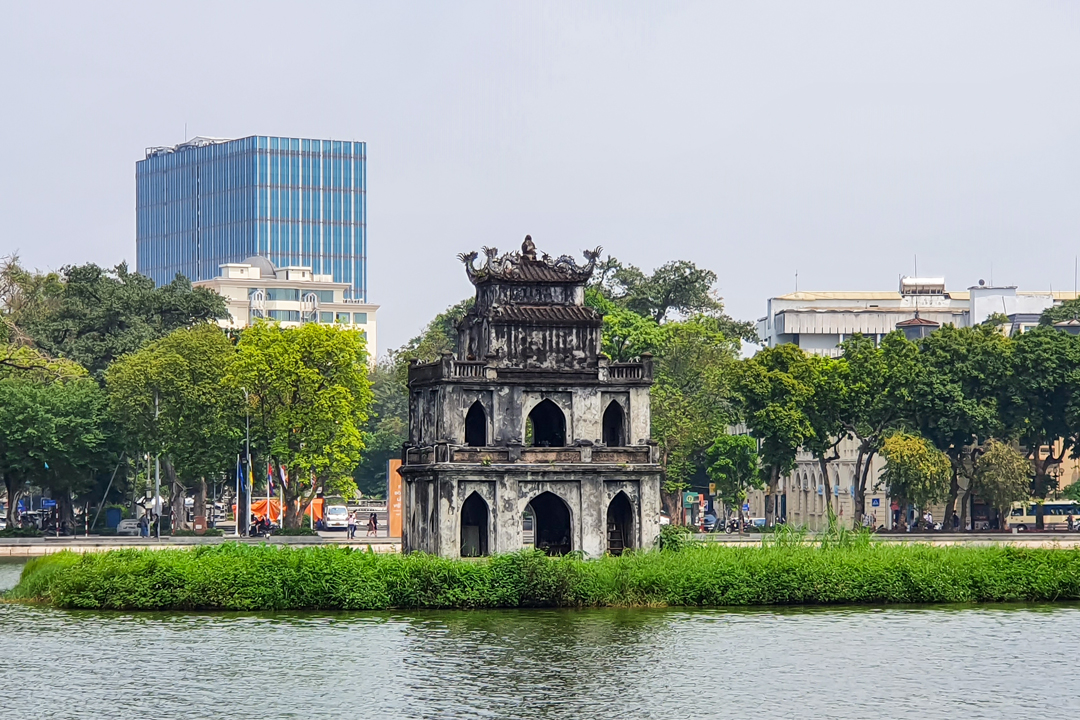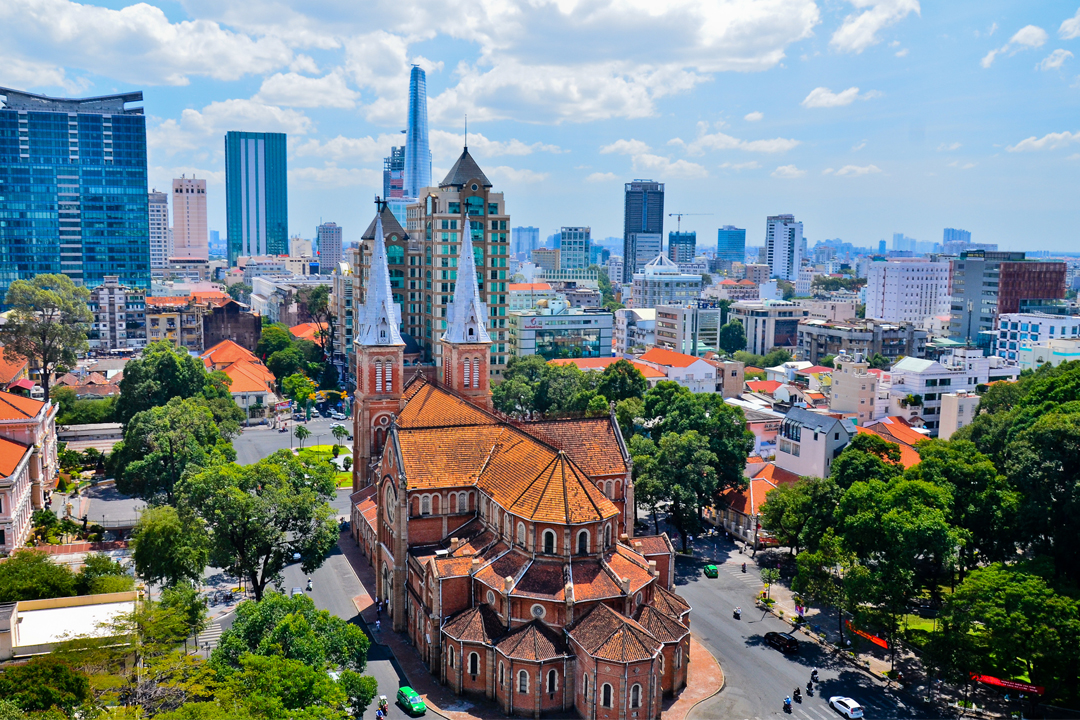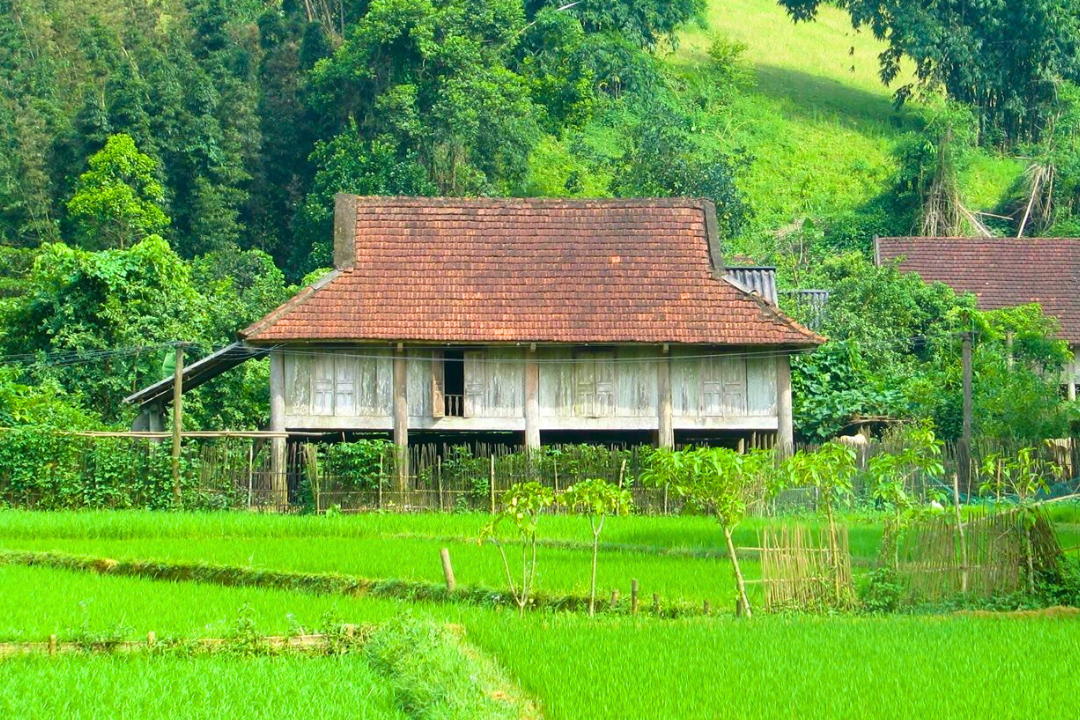May - 27 - 2025
Just a short drive from Hanoi’s dynamic center lies Quang Phu Cau, a quiet commune in Ung Hoa district that comes alive with color, fragrance, and tradition. Located about 35 kilometers southwest of the capital, this unique village has become a symbol of Vietnam’s rich cultural tapestry, thanks to its centuries-old incense-making craft. Here, the air is filled with the delicate scent of aromatic sticks, and the ground bursts with vivid displays of dyed bamboo arranged like blooming flowers. Generations of local artisans have preserved and perfected this intricate process, turning humble materials into stunning cultural icons. In this article of GTrip, you can learn why Quang Phu Cau leaves a lasting impression on tourists.
History of Quang Phu Cau Incense Village
Quang Phu Cau’s incense-making tradition dates back over a century, with some sources suggesting it began as early as the 15th century during the reign of King Le Thanh Tong. This was a golden era for Vietnamese arts and crafts. Initially, villagers made incense as a side occupation between farming seasons. Over time, as demand grew, it transformed into the village’s primary livelihood. The craft even played an unexpected role during the Vietnam War, when the strong scent of incense helped mask the smell of gunpowder, aiding Vietnamese soldiers in maintaining the element of surprise during combat.
Incense holds deep spiritual meaning in Vietnamese culture. It is an essential part of both religious ceremonies and ancestral worship, believed to carry prayers to deities and departed loved ones. The fragrant smoke symbolizes peace, prosperity, spiritual purification, and a sacred bridge between the living and the dead. This ritual practice, passed down through generations, continues to be honored in homes, temples, and communal gatherings throughout the country.
Today, Quang Phu Cau is one of Vietnam’s most iconic incense-making villages, drawing global attention for both its cultural depth and striking visuals. The sight of thousands of brightly colored incense sticks drying in radiant, flower-like formations has captivated photographers and artists worldwide. These vivid displays not only showcase the beauty of the craft but also help preserve a sacred tradition that remains at the heart of Vietnamese identity.
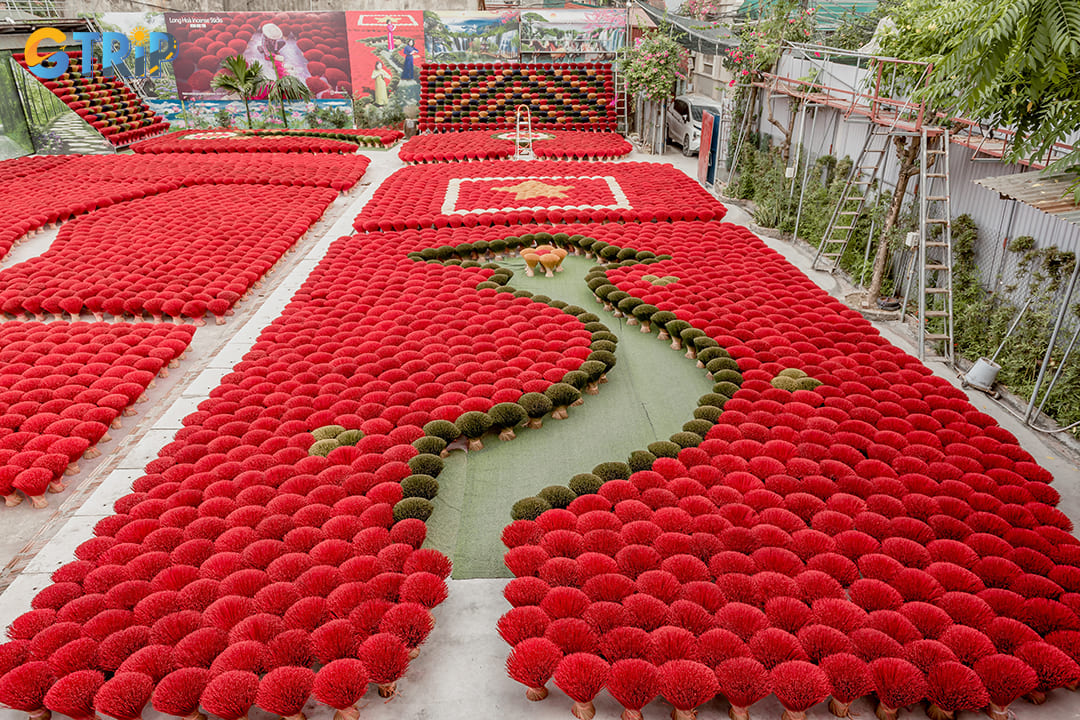
Quang Phu Cau’s incense-making tradition dates back over a century
Traditional incense-making at Quang Phu Cau Village
At Quang Phu Cau village, about 35km southwest of Hanoi, the art of incense-making has flourished for nearly a century. This meticulous craft originated in Phu Luong Thuong hamlet before gradually spreading throughout the commune. It has become the lifeblood of local families who have preserved and perfected these techniques across generations. Today, the village's vibrant fields of drying incense have become not only economic sustenance for residents but also an unexpected visual feast for photographers and travelers.
The incense production process follows a carefully orchestrated sequence that combines traditional knowledge with artistic precision. Each step contributes to creating the fragrant sticks that will eventually burn in temples, pagodas, and homes across Vietnam and beyond:
The bamboo selection process:
- Only mature bamboo stalks with appropriate density and durability are selected
- Primary bamboo sources include northern Vietnamese provinces like Bac Kan, Lang Son, Thai Nguyen, and Thanh Hoa
- Quality inspection ensures only premium materials enter production
- Local craftsmen can identify suitable bamboo by texture, weight, and visual appearance
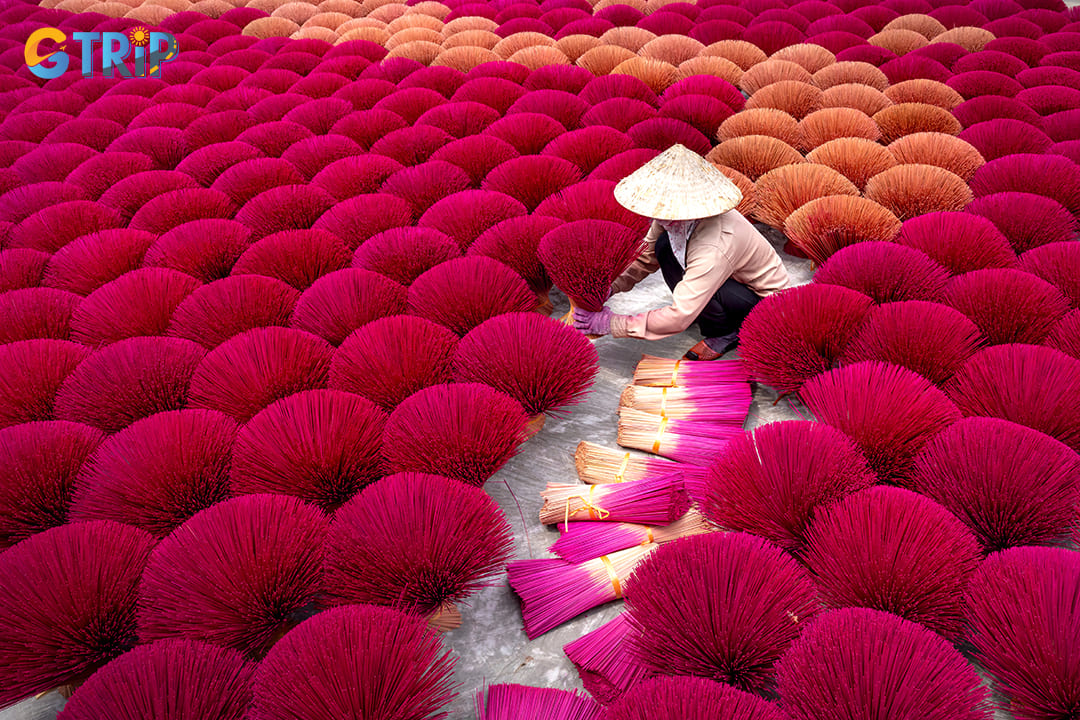
The incense production process follows a carefully orchestrated sequence that combines traditional knowledge with artistic precision
The incense-making process in Quang Phu Cau is a meticulous blend of craftsmanship and tradition. It begins with carefully selected bamboo, which is cut into slender sticks about 50-60cm long. These are precisely split to ensure uniformity, too thick and they won’t burn well, too thin and they risk breaking. The sticks are then laid out in circular formations to dry under the sun, creating the first of many photogenic scenes that draw travelers and photographers alike.
Once dried, the sticks are dyed in vibrant hues. While traditional reds and pinks, symbols of luck and happiness, remain popular, modern demands have introduced a wider palette including purples, greens, and blues. After dyeing, the sticks are again sun-dried in striking geometric arrangements, forming the iconic “incense flowers” that have made the village a visual marvel. Meanwhile, families prepare aromatic pastes from guarded recipes blending cinnamon bark, agarwood, frankincense, pine resin, clove, and other herbs.
Artisans then apply the fragrant paste to the sticks using either traditional hand-dipping methods for high-quality incense or semi-automated machines for larger batches. A final drying phase lasting one to three days allows the aromas to set and ensures smooth burning. The finished sticks are bundled and packaged, some in ornate wrappings for rituals, others in bulk for everyday use, ready to carry Quang Phu Cau’s heritage across Vietnam and beyond.
What makes Quang Phu Cau's incense truly special is the perfect balance between artisanal techniques and modest mechanization. While some larger producers use machines for parts of the process, many families still rely on handcrafting. This preserves traditional skills that ensure the incense burns evenly and releases its fragrance at just the right pace.
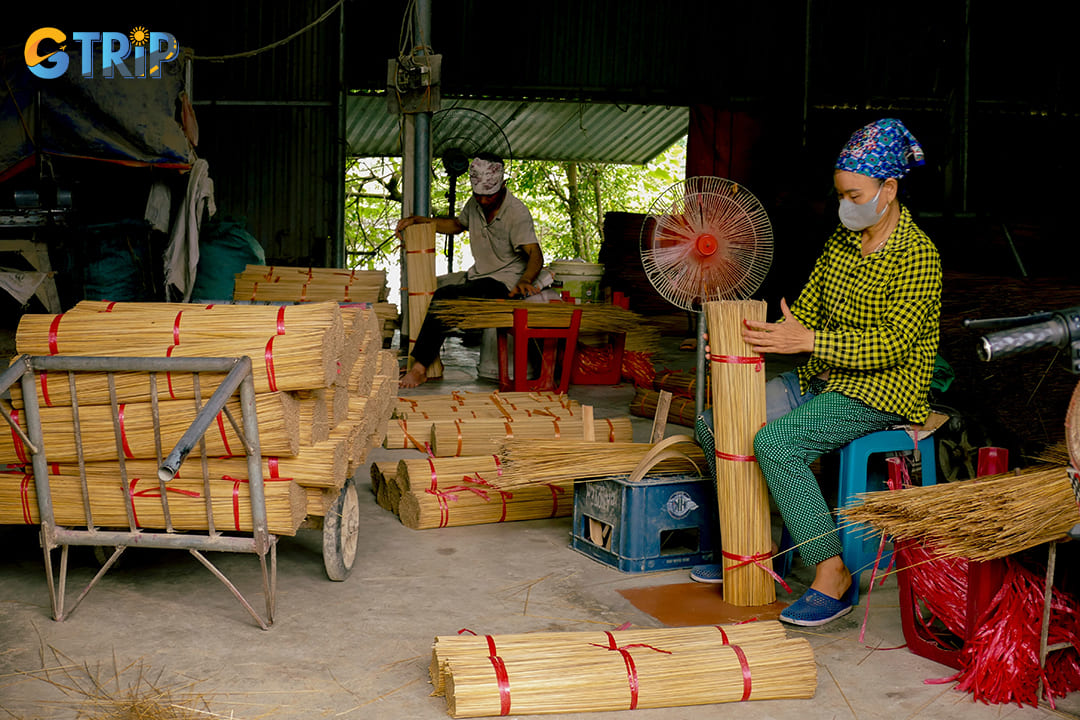
The incense-making process in Quang Phu Cau is a meticulous blend of craftsmanship and tradition
Things to do at Quang Phu Cau Incense Village
Quang Phu Cau Incense Village offers tourists a mesmerizing sensory experience with its vibrant colors, aromatic scents, and authentic cultural immersion. This traditional craft village provides numerous activities that showcase Vietnam's artisanal heritage while creating unforgettable photo opportunities.
Discover and participate in the traditional incense-making process
The heart of Quang Phu Cau's allure lies in its traditional incense-making process, which tourists can both observe and join. Local artisans warmly welcome tourists into their workshops, where generations of expertise are on display through carefully choreographed demonstrations.
During these interactive sessions, you'll learn about each meticulous step of incense creation:
- Bamboo preparation: Witnessing how bamboo sticks are split, cut, and prepared as the base
- Powder mixing: Learning about the natural materials used to create the aromatic paste
- Coating technique: Observing the distinctive hand-rolling method that coats each stick
- Traditional tools: Handling specialized equipment passed down through generations
Many workshops offer hands-on experiences where you can try creating your own incense sticks under the guidance of master craftspeople. This participatory activity provides deeper cultural insights while supporting local families who have maintained these traditions for centuries.
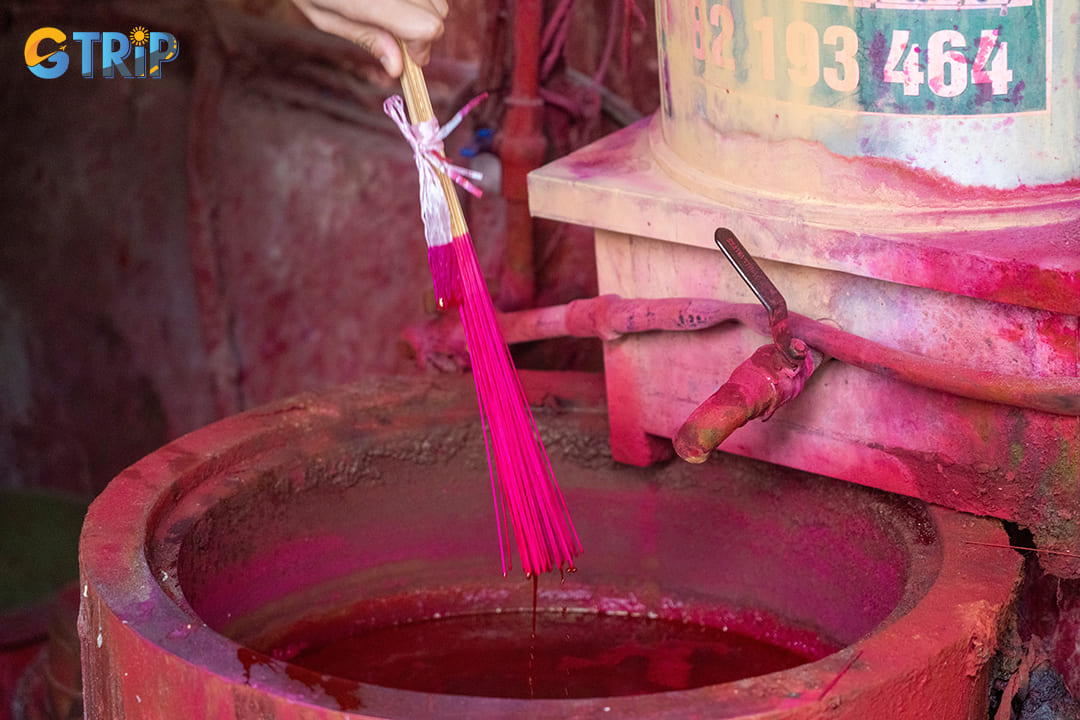
The heart of Quang Phu Cau's allure lies in its traditional incense-making process, which tourists can both observe and join
Explore the colorful incense drying fields
The most visually stunning aspect of Quang Phu Cau is undoubtedly its expansive drying fields, where thousands of freshly-made incense sticks create a breathtaking crimson landscape. These vibrant panoramas have made the village internationally famous on Instagram and travel magazines.
Walking through these vast fields offers different perspectives depending on the angle and time of day:
| Time of day | Lighting effect | Photography advantage |
|---|---|---|
| Early morning (6 - 8 am) | Soft, golden light | Fewer visitors, misty atmosphere |
| Mid-morning (9 - 11 am) | Bright, clear light | Vivid colors, good contrast |
| Late afternoon (3 - 5 pm) | Warm, directional light | Dramatic shadows, golden tones |
As you wander, you'll notice various drying techniques employed, from vertical arrangements resembling fiery bushes to circular formations creating mesmerizing wheel patterns. The incense sticks require approximately one week to dry completely, which means the fields maintain their vibrant appearance year-round, though the specific areas being used may shift.
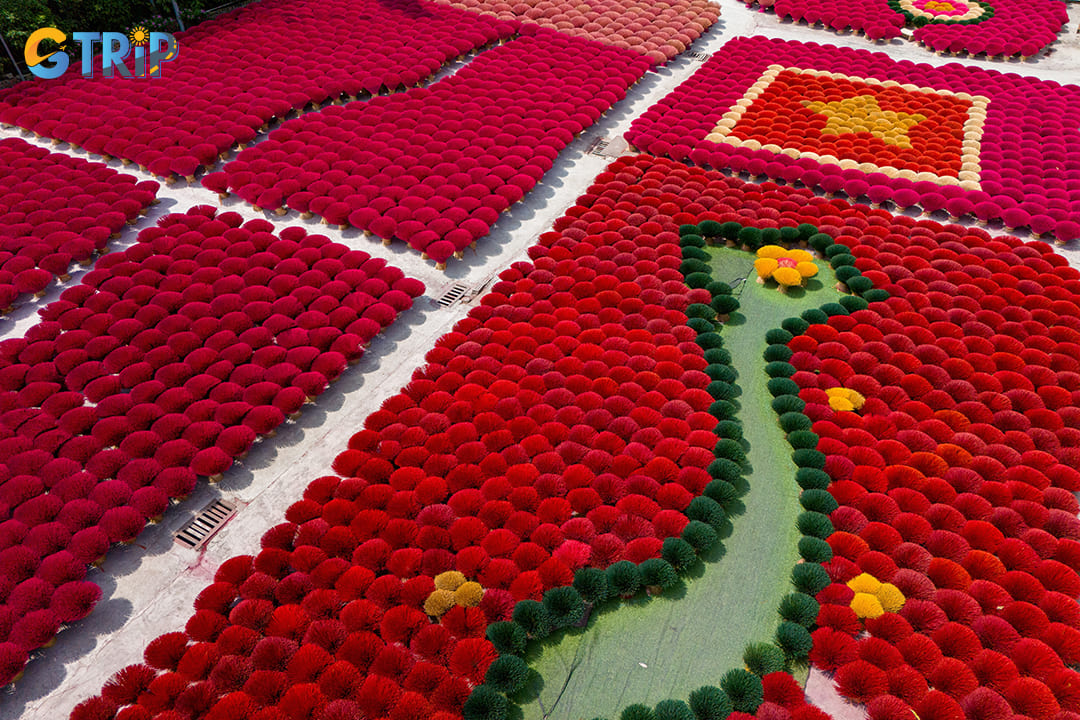
The most visually stunning aspect of Quang Phu Cau is its expansive drying fields, where thousands of freshly-made incense sticks create a breathtaking crimson landscape
Shop for premium incense and village specialties
Quang Phu Cau offers excellent shopping opportunities for those seeking authentic Vietnamese handicrafts and aromatic souvenirs. The village's products are renowned for their quality, fragrance, and traditional production methods.
The village marketplace features various incense products worth considering:
- Standard incense sticks: Available in multiple scents, sizes, and quantities
- Premium sandalwood and agarwood varieties: Higher-quality options with longer burn times
- Decorative incense holders: Handcrafted ceramic and wooden burners
- Incense coils: Spiral-shaped incense that burns slowly for hours
- Gift sets: Beautifully packaged collections ideal for souvenirs
Beyond incense, local shops sell related handicrafts including handwoven bamboo baskets, ceramic goods, and traditional Vietnamese religious items. Purchasing directly from village artisans ensures authenticity while contributing to the preservation of this cultural heritage. Most vendors accept cash (Vietnamese Dong), though larger establishments may accept credit cards or mobile payments.
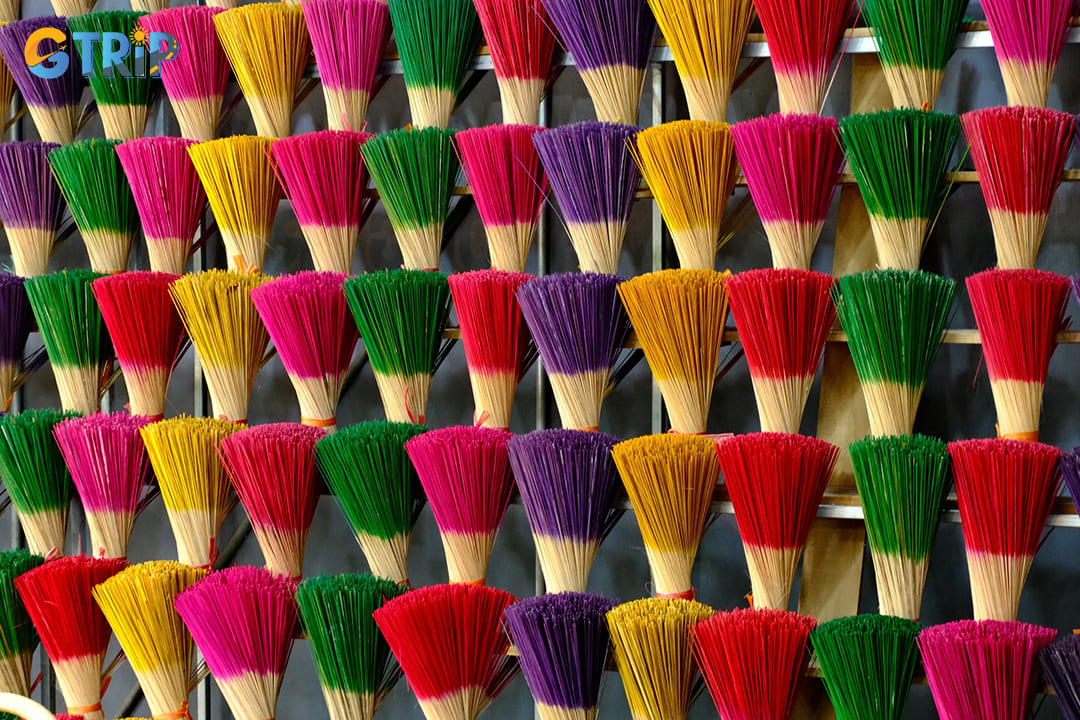
Quang Phu Cau offers excellent shopping opportunities for those seeking authentic Vietnamese handicrafts and aromatic souvenirs
Check in with a beautiful background of incense
Quang Phu Cau has become a photographer's paradise, offering countless striking compositions against its vivid red backdrops. The village provides ideal settings for memorable images.
Some photography tips for capturing the perfect shots:
- Wear contrasting colors: White, blue, or yellow clothing stands out beautifully against the red incense
- Experiment with perspectives: Try shooting from different heights and angles for varied compositions
- Include people for scale: Having a subject among the incense helps convey the impressive size of the fields
- Focus on details: Capture close-ups of the incense-making process and textural elements
- Respect the workspace: Always ask permission before photographing workers or entering active drying areas
For the best lighting conditions, plan your photography session during the "golden hours" , shortly after sunrise or before sunset. These periods provide soft, directional light that enhances the rich colors of the incense sticks and minimizes harsh shadows.
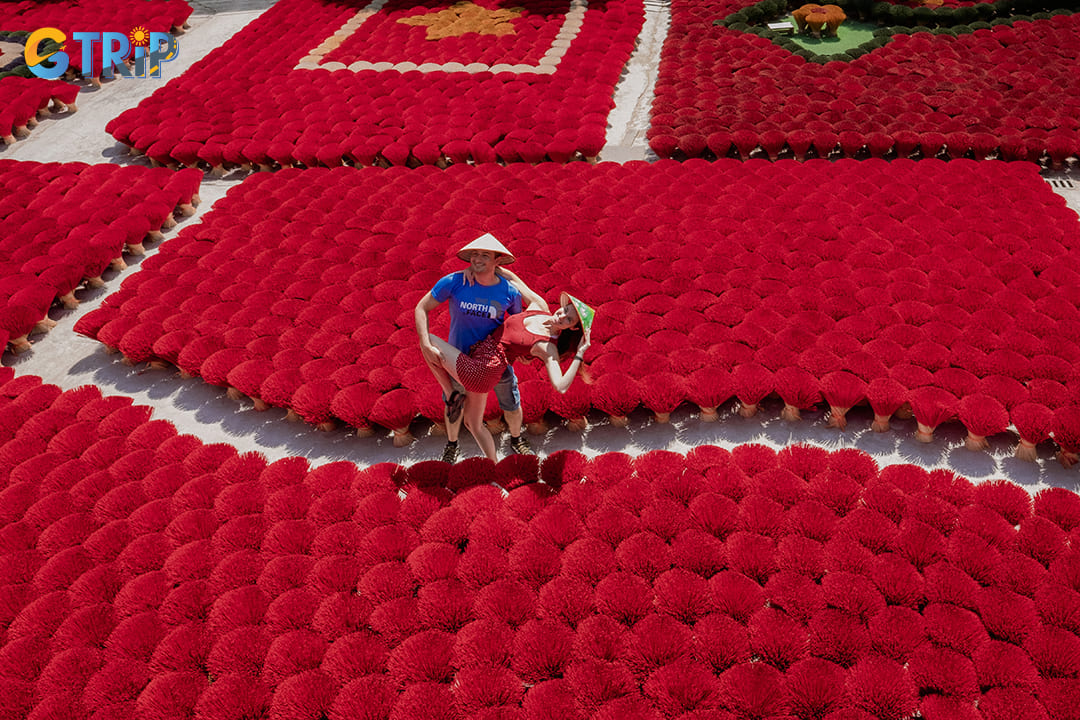
Quang Phu Cau has become a photographer's paradise, offering countless striking compositions against its vivid red backdrops
Stroll around the village to enjoy the atmosphere
Beyond the colorful incense fields, Quang Phu Cau offers a genuine look into rural Vietnamese life. Wandering through its narrow lanes reveals scenes of daily routines that add depth to the craft-centered experience. The village atmosphere shifts throughout the day: mornings are lively with production and market activity, while midday brings a quiet lull as families prepare lunch. Afternoons are more relaxed, with children returning from school and neighbors gathering to chat, and evenings reflect a strong sense of family and community life.
As you explore, notice how incense-making blends seamlessly with daily living. Many homes display small incense bundles outside, adding bursts of color and gentle fragrance throughout the village. The scent drifts through the air, turning an ordinary stroll into a rich sensory experience. Take time to engage with the locals, who are often welcoming and proud to share their stories. Though not everyone speaks English, a warm smile and a translation app can lead to heartfelt conversations about their craft, traditions, and way of life.
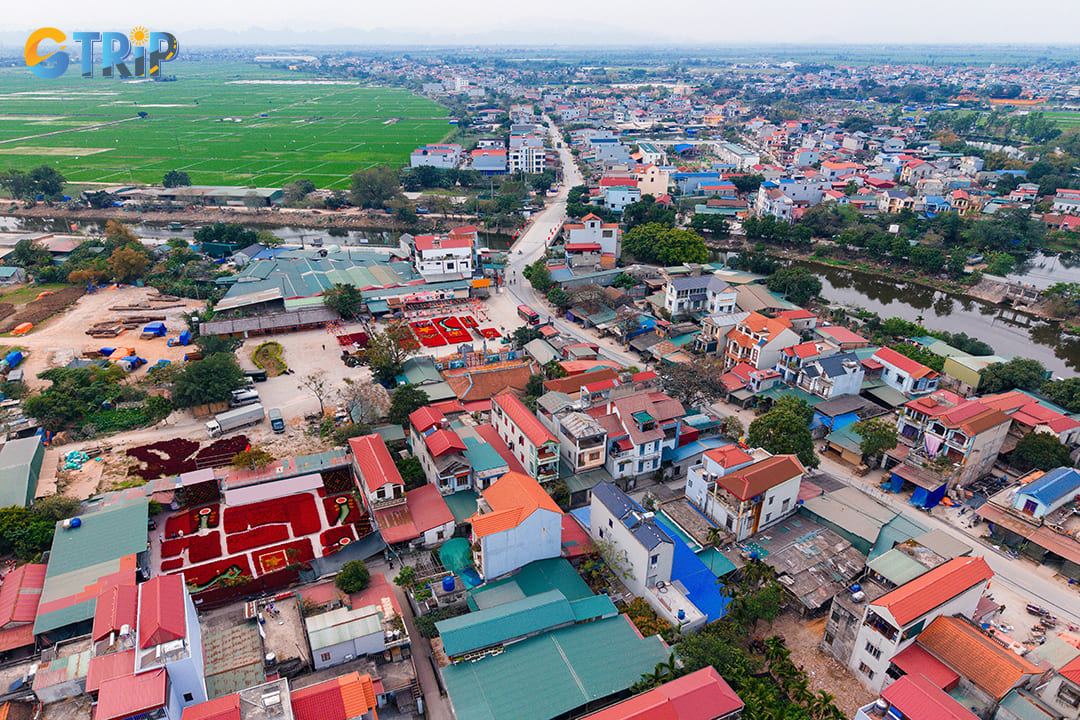
Beyond the colorful incense fields, Quang Phu Cau offers a genuine look into rural Vietnamese life
Opening hours and entrance fees of Quang Phu Cau Incense Village
Quang Phu Cau Incense Village operates differently from conventional tourist attractions as it's an authentic working village where local artisans carry out their traditional craft daily. Understanding the informal nature of visiting hours and costs will help you plan a more enjoyable experience to this vibrant destination.
Visiting hours
The village doesn't maintain official opening or closing times, as it's primarily a functioning residential and production area. Most incense-making activities happen during daylight hours when:
- Early morning (7:00 AM - 9:00 AM): Villagers begin their workday, setting up production areas and preparing materials
- Mid-morning to afternoon (9:00 AM - 3:00 PM): Peak production hours with most active incense-making and drying activities
- Late afternoon (3:00 PM - 5:00 PM): Final production work and clean-up before ending the day
- Weekends: Activity levels remain similar to weekdays as production continues throughout the week
For the best experience, arriving between 8:00 AM and 2:00 PM ensures you'll witness the village at its most active, with optimal lighting conditions for photography.
Entrance costs and photography fees
As a working community rather than a commercialized attraction, Quang Phu Cau doesn't charge formal admission fees to enter the village itself. However, you should be aware of potential small costs:
| Fee type | Cost range (VND) | Approximate USD | Notes |
|---|---|---|---|
| Village entry | Free | $0 | No charge to walk through public areas |
| Private property access | 50,000 - 100,000 | $2 - $4 | For entering family workshops or prime photo areas |
| Photography permission | 20,000 - 50,000 | $1 - $2 | Sometimes requested in certain yards |
| Guide services | 150,000 - 300,000 | $6 - $12 | Optional local guides (per group) |
Some villagers who allow tourists onto their property or into their drying yards may request these small fees as compensation for access to their private spaces and for permission to photograph their colorful arrangements. These modest contributions help support local families while maintaining this remarkable cultural treasure.
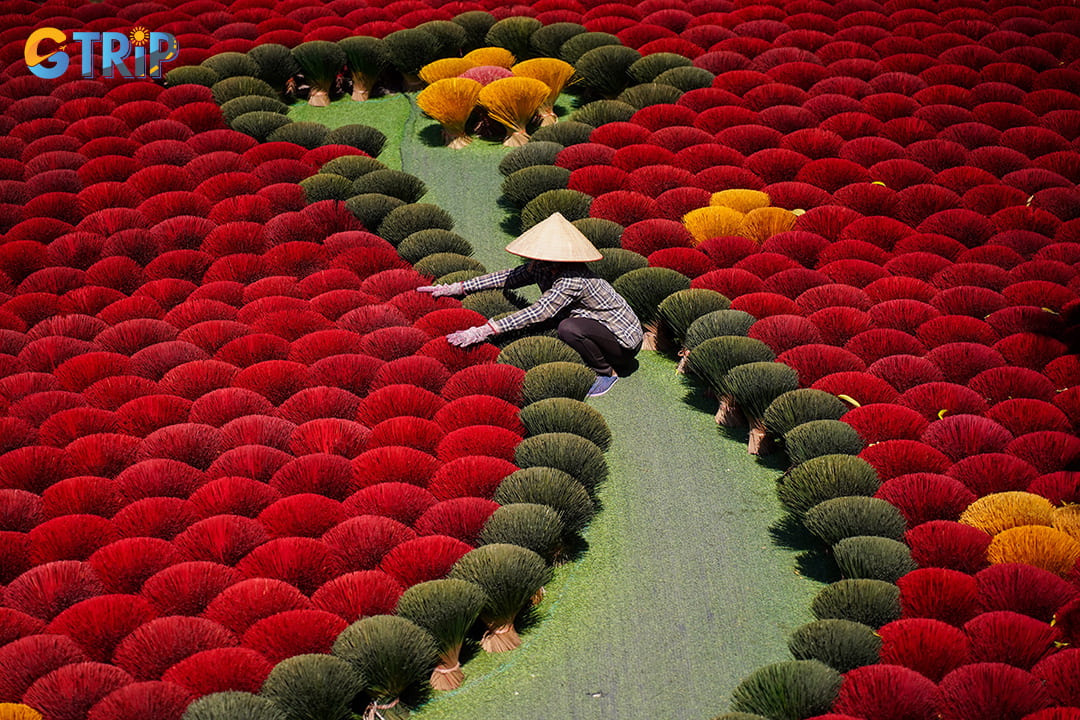
The village doesn't maintain official opening or closing times, as it's primarily a functioning residential and production area
Best times to visit Quang Phu Cau Village
Timing your visit to Quang Phu Cau Incense Village can dramatically enhance your experience at this vibrant cultural destination. The village comes alive in the early morning when incense production is in full swing and natural lighting conditions create the perfect atmosphere.
The optimal hours for visiting are between 9:00 AM and 10:30 AM. During this morning window, you'll observe craftspeople actively engaged in the incense-making process while enjoying cooler temperatures before the midday heat. The soft morning light also creates picture-perfect conditions, illuminating the vibrant red and pink incense displays that have made this village Instagram-famous.
If you're a photography enthusiast, the golden hour (around sunrise or sunset) offers exceptional lighting conditions. The early morning golden hour (5:30 AM - 7:00 AM) provides a mystical atmosphere with fewer tourists. The evening golden hour (5:00 PM - 6:30 PM, depending on season) bathes the incense sticks in warm, flattering light.
Winter (November - March) offers cool, dry weather and marks peak incense production for Tet, ideal for seeing the village at its busiest. Spring (March - April) brings mild temperatures and fewer tourists. Summer (May - September) is hot and humid with afternoon rains, visit early in the day to avoid the heat. Autumn (October - November) is the most pleasant, with clear skies and perfect light for photography.
Weekdays provide a quieter, more authentic experience compared to weekends, when Hanoi locals often visit. Avoid major holidays like Tet, when production may pause. For the most vibrant scenes, visit 1 - 2 months before Tet (December–January), when the village is filled with colorful incense displays and round-the-clock activity.

The village comes alive in the early morning when incense production is in full swing and natural lighting conditions create the perfect atmosphere.
How to get to Quang Phu Cau Incense Village?
Reaching the vibrant incense-making community of Quang Phu Cau is relatively straightforward, as it's located about 35km southwest of Hanoi's city center.
By bus
Taking a public bus is the most economical option for budget travelers wanting to reach Quang Phu Cau.
Bus route options:
- Take bus 207 from My Dinh bus station to Ung Hoa town
- Transfer to a local bus or motorbike taxi (xe om) for the remaining 5km to the village
Price range:
| Transportation | Cost in VND | Cost in USD |
|---|---|---|
| Bus fare to Ung Hoa | 9,000 - 15,000 VND | $0.35 - 0.60 |
| Local bus/xe om to village | 20,000 - 50,000 VND | $0.80 - 2.00 |
| Total estimated cost | 29,000 - 65,000 VND | $1.15 - 2.60 |
The journey by bus takes approximately 1.5 - 2 hours, depending on traffic conditions. While this option is cost-effective, it requires more time and potentially dealing with crowded buses during peak hours. Bus schedules typically run from early morning (around 5:30 AM) until evening (around 7:00 PM).
By car or taxi/Grab:
Hiring a private car, taxi, or using ride-sharing apps like Grab provides the most comfort and convenience for travelers. A private car or taxi can be arranged from your accommodation in Hanoi, with the journey taking approximately 50 - 70 minutes, depending on traffic conditions. This option is ideal for families, groups, or those preferring door-to-door service without navigating public transportation.
Price range:
| Service type | Cost in VND | Cost in USD |
|---|---|---|
| Grab car (one-way) | 350,000 - 450,000 VND | $14-18 |
| Traditional taxi (one-way) | 450,000 - 600,000 VND | $18-24 |
| Private car hire (round-trip, half-day) | 800,000 - 1,200,000 VND | $32-48 |
Many drivers may wait while you explore the village for an additional fee, which is worth negotiating beforehand if you plan a short visit. This option provides maximum flexibility with your schedule and the ability to stop at other attractions along the way.
By motorbike
Renting and riding a motorbike to Quang Phu Cau is popular among adventurous travelers who want independence and the chance to experience Vietnamese road culture firsthand. The route is straightforward; follow Highway 21B southwest from Hanoi. The journey takes approximately 1-1.5 hours, depending on your riding pace and traffic conditions. A detailed map or GPS navigation is recommended as there may be limited signage to the village.
Price range:
| Item | Cost in VND | Cost in USD |
|---|---|---|
| Daily motorbike rental | 100,000 - 200,000 VND | $4-8 |
| Fuel (round trip) | 40,000 - 70,000 VND | $1.60-2.80 |
| Total estimated cost | 140,000 - 270,000 VND | $5.60-10.80 |
Be sure to wear a helmet, bring appropriate rain gear (depending on the season), and have your international driver's license. While this option offers the most freedom, it's only recommended for those experienced with riding in Vietnamese traffic conditions.
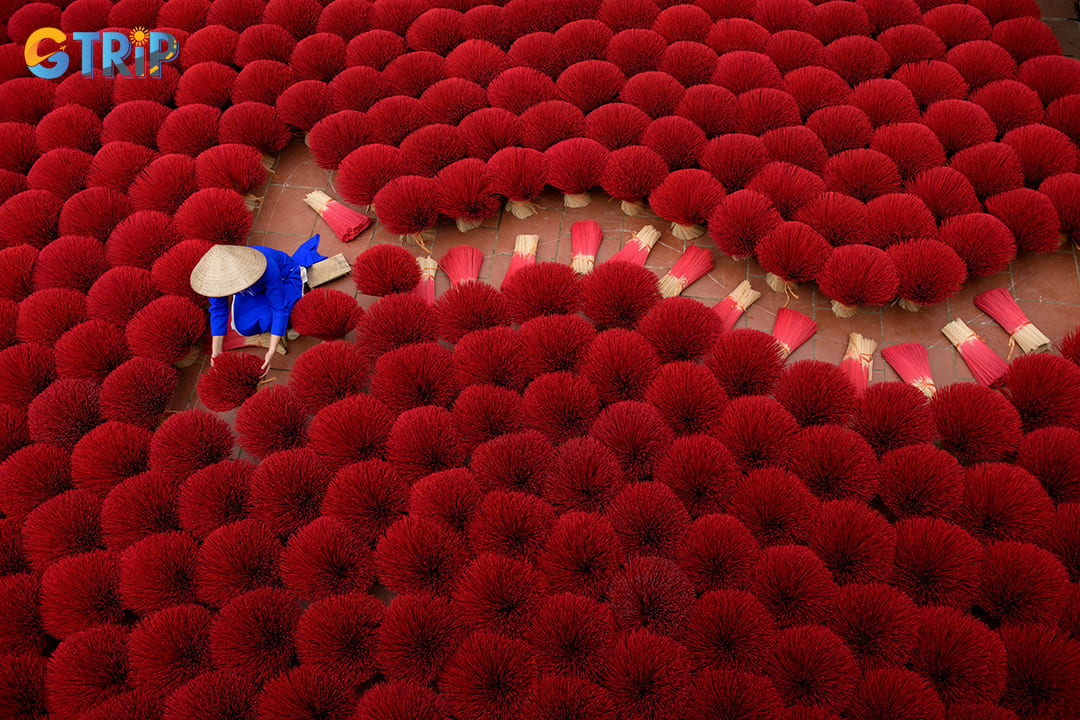
Reaching the vibrant incense-making community of Quang Phu Cau is relatively straightforward
Travel tips to Quang Phu Cau Incense Village
To make the most of your trip, a bit of planning goes a long way. Here are some key tips:
- Dress comfortably: Wear breathable clothes and sturdy shoes, as you'll be walking through narrow, sometimes uneven paths between drying areas.
- Protect yourself from the sun: Bring sunscreen, a hat, and sunglasses; most incense-drying fields are open with little shade.
- Carry cash: Small vendors don’t accept cards. Bring enough Vietnamese dong for souvenirs, drinks, or small donations.
- Be respectful with photos: Always ask permission before photographing locals, especially in private spaces.
- Consider a local guide: A guide can enhance your visit with cultural insights and help you connect with artisans.
- Go on weekdays: Weekday visits are quieter and give you a more authentic glimpse into daily village life.
- Don’t disturb incense displays: The colorful sticks are valuable products, admire them, but don’t touch them without permission.

To make the most of your trip, a bit of planning goes a long way
Visiting Quang Phu Cau incense village unveils a tapestry of tradition and artistry that stays with you long after the dust has settled on your shoes. The vibrant colors of thousands of incense sticks, harmoniously arranged like blooming flowers, invite you to dive into Vietnam’s rich cultural heritage.
By exploring this hidden gem with GTrip as your guide, you're not just witnessing a craft but connecting with the souls who breathe life into it every day. If you're curious about other unique destinations, there's always more to discover around every corner waiting to enrich your next journey. Consider booking tours of GTrip - Vietnam Travel Agency to explore Quang Phu Cau Incense Village and other attractions around Hanoi.

